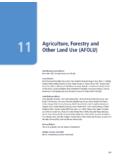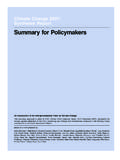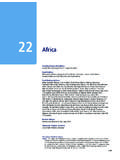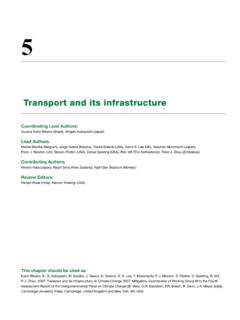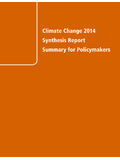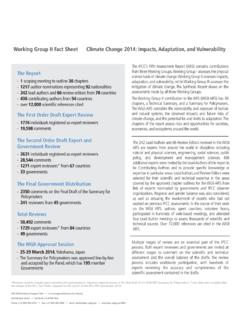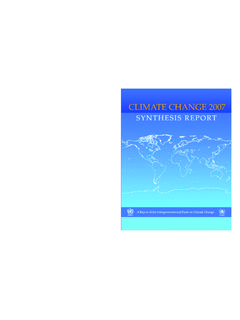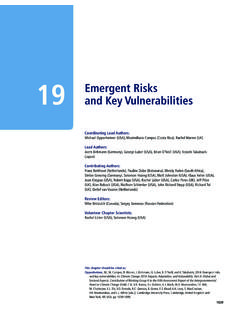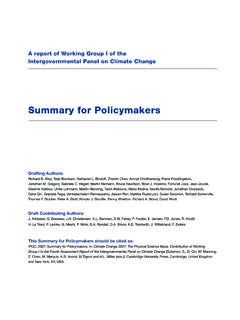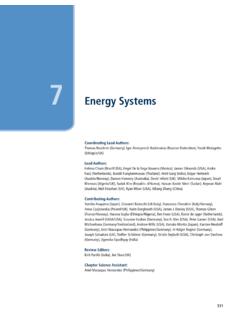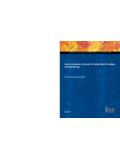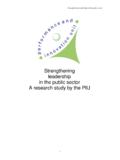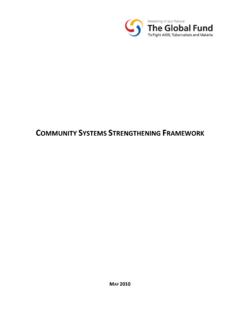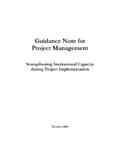Transcription of Summary for Policymakers - IPCC
1 XxiTechnical SummarySummary for Policymakers1 SPMD rafting Authors: Ottmar Edenhofer (Germany), Ram n Pichs-Madruga (Cuba), Youba Sokona (Mali), Shardul Agrawala (France), Igor Alexeyevich Bashmakov (Russia), Gabriel Blanco (Argentina), John Broome (UK), Thomas Bruckner (Germany), Steffen Brunner (Germany), Mercedes Bustamante (Brazil), Leon Clarke (USA), Felix Creutzig (Germany), Shobhakar Dhakal (Nepal / Thailand), Navroz K. Dubash (India), Patrick Eickemeier (Germany), Ellie Farahani (Canada), Manfred Fischedick (Germany), Marc Fleurbaey (France), Reyer Gerlagh (Netherlands), Luis G mez-Echeverri (Colombia / Austria), Sujata Gupta (India / Philippines), Jochen Harnisch (Germany), Kejun Jiang (China), Susanne Kadner (Germany), Sivan Kartha (USA), Stephan Klasen (Germany), Charles Kolstad (USA), Volker Krey (Austria / Germany), Howard Kunreuther (USA), Oswaldo Lucon (Brazil), Omar Masera (M xico), Jan Minx (Germany), Yacob Mulugetta (Ethiopia / UK), Anthony Patt (Austria / Switzerland), Nijavalli H.
2 Ravindranath (India), Keywan Riahi (Austria), Joyashree Roy (India), Roberto Schaeffer (Brazil), Steffen Schl mer (Germany), Karen Seto (USA), Kristin Seyboth (USA), Ralph Sims (New Zealand), Jim Skea (UK), Pete Smith (UK), Eswaran Somanathan (India), Robert Stavins (USA), Christoph von Stechow (Germany), Thomas Sterner (Sweden), Taishi Sugiyama (Japan), Sangwon Suh (Republic of Korea / USA), Kevin Chika Urama (Nigeria / UK / Kenya), Diana rge-Vorsatz (Hungary), David G. Victor (USA), Dadi Zhou (China), Ji Zou (China), Timm Zwickel (Germany)Draft Contributing AuthorsGiovanni Baiocchi (UK / Italy), Helena Chum (Brazil / USA), Jan Fuglestvedt (Norway), Helmut Haberl (Austria), Edgar Hertwich (Austria / Norway), Elmar Kriegler (Germany), Joeri Rogelj (Switzerland / Belgium), Rogner (Germany), Michiel Schaeffer (Netherlands), Steven J. Smith (USA), Detlef van Vuuren (Netherlands), Ryan Wiser (USA)This Summary for Policymakers should be cited as:IPCC, 2014: Summary for Policymakers .
3 In: Climate Change 2014: Mitigation of Climate Change. Contribution of Work-ing Group III to the Fifth Assessment Report of the Intergovernmental Panel on Climate Change [Edenhofer, O., R. Pichs-Madruga, Y. Sokona, E. Farahani, S. Kadner, K. Seyboth, A. Adler, I. Baum, S. Brunner, P. Eickemeier, B. Kriemann, J. Savolainen, S. Schl mer, C. von Stechow, T. Zwickel and Minx (eds.)]. Cambridge University Press, Cambridge, United Kingdom and New York, NY, for PolicymakersSPM3 SPMS ummary for PolicymakersSPMSPMT able of Introduction .. Approaches to climate change mitigation .. Trends in stocks and flows of greenhouse gases and their drivers .. Mitigation pathways and measures in the context of sustainable development .. Long-term mitigation pathways .. Sectoral and cross-sectoral mitigation pathways and measures .. Cross-sectoral mitigation pathways and measures .. Energy supply.
4 Energy end-use sectors .. Agriculture, Forestry and Other Land Use (AFOLU) .. Human settlements, infrastructure and spatial planning .. Mitigation policies and institutions .. Sectoral and national policies .. International cooperation ..304 SPMS ummary for PolicymakersSummary for PolicymakersSPMI ntroductionThe Working Group III contribution to the IPCC s Fifth Assessment Report (AR5) assesses literature on the scientific, technological, environmental, economic and social aspects of mitigation of climate change. It builds upon the Working Group III contribution to the IPCC s Fourth Assessment Report (AR4), the Special Report on Renewable Energy Sources and Climate Change Mitigation (SRREN) and previous reports and incorporates subsequent new findings and research. The report also assesses mitigation options at different levels of governance and in different economic sectors, and the societal implications of different mitigation policies , but does not recommend any particular option for Summary for Policymakers (SPM) follows the structure of the Working Group III report.
5 The narrative is supported by a series of highlighted conclusions which, taken together, provide a concise Summary . The basis for the SPM can be found in the chapter sections of the underlying report and in the Technical Summary (TS). References to these are given in square degree of certainty in findings in this assessment, as in the reports of all three Working Groups, is based on the author teams evaluations of underlying scientific understanding and is expressed as a qualitative level of confidence (from very low to very high) and, when possible, probabilistically with a quantified likelihood (from exceptionally unlikely to virtually certain). Confidence in the validity of a finding is based on the type, amount, quality, and consistency of evidence (e. g., data, mechanistic understanding, theory, models, expert judgment) and the degree of Probabilistic estimates of quantified measures of uncertainty in a finding are based on statistical analysis of observations or model results, or both, and expert Where appropriate, findings are also formulated as statements of fact without using uncertainty qualifiers.
6 Within paragraphs of this Summary , the confidence, evidence, and agreement terms given for a bolded finding apply to subsequent statements in the paragraph, unless additional terms are to climate change mitigationMitigation is a human intervention to reduce the sources or enhance the sinks of greenhouse gases. Mitiga-tion, together with adaptation to climate change, contributes to the objective expressed in Article 2 of the United Nations Framework Convention on Climate Change (UNFCCC):The ultimate objective of this Convention and any related legal instruments that the Conference of the Parties may adopt is to achieve, in accordance with the relevant provisions of the Convention, stabilization of greenhouse gas concentrations in the atmosphere at a level that would prevent dangerous anthropogenic interference with the climate system. Such a level should be achieved within a time frame sufficient to allow ecosystems to adapt natu-rally to climate change, to ensure that food production is not threatened and to enable economic development to proceed in a sustainable policies can be informed by the findings of science, and systematic methods from other disciplines.
7 [ , , , Box ]1 The following Summary terms are used to describe the available evidence: limited, medium, or robust; and for the degree of agreement: low, medium, or high. A level of confidence is expressed using five qualifiers: very low, low, medium, high, and very high, and typeset in italics, e. g., medium confidence. For a given evidence and agreement statement, different confidence levels can be assigned, but increasing levels of evidence and degrees of agreement are correlated with increasing confidence. For more details, please refer to the guidance note for Lead Authors of the IPCC Fifth Assessment Report on consistent treatment of The following terms have been used to indicate the assessed likelihood of an outcome or a result: virtually certain 99 100 % probability, very likely 90 100 %, likely 66 100 %, about as likely as not 33 66 %, unlikely 0 33 %, very unlikely 0 10 %, exceptionally unlikely 0 1 %.
8 Addi-tional terms (more likely than not > 50 100 %, and more unlikely than likely 0 < 50 %) may also be used when appropriate. Assessed likelihood is typeset in italics, e. g., very for PolicymakersSustainable development and equity provide a basis for assessing climate policies and highlight the need for addressing the risks of climate Limiting the effects of climate change is necessary to achieve sustainable development and equity, including poverty eradication. At the same time, some mitigation efforts could undermine action on the right to promote sustainable development, and on the achievement of poverty eradication and equity. Conse-quently, a comprehensive assessment of climate policies involves going beyond a focus on mitigation and adaptation policies alone to examine development pathways more broadly, along with their determinants. [ , , , , , ]Effective mitigation will not be achieved if individual agents advance their own interests independently.
9 Climate change has the characteristics of a collective action problem at the global scale, because most greenhouse gases (GHGs) accumulate over time and mix globally, and emissions by any agent (e. g., individual, community, company, country) affect other International cooperation is therefore required to effectively mitigate GHG emissions and address other climate change issues [ , , , , , ]. Furthermore, research and development in support of mitigation creates knowledge spillovers. International cooperation can play a constructive role in the development, dif-fusion and transfer of knowledge and environmentally sound technologies [ , , , , ].Issues of equity, justice, and fairness arise with respect to mitigation and Countries past and future contributions to the accumulation of GHGs in the atmosphere are different, and countries also face varying chal-lenges and circumstances, and have different capacities to address mitigation and adaptation.
10 The evidence suggests that outcomes seen as equitable can lead to more effective cooperation. [ , , ]Many areas of climate policy-making involve value judgements and ethical considerations. These areas range from the question of how much mitigation is needed to prevent dangerous interference with the climate system to choices among specific policies for mitigation or adaptation [ , ]. Social, economic and ethical analyses may be used to inform value judgements and may take into account values of various sorts, including human wellbeing, cultural values and non-human values [ , ].Among other methods, economic evaluation is commonly used to inform climate policy design. Practical tools for economic assessment include cost-benefit analysis, cost-effectiveness analysis, multi-criteria analysis and expected utility theory [ ]. The limitations of these tools are well-documented [ ]. Ethical theories based on social welfare functions imply that distributional weights, which take account of the different value of money to different people, should be applied to monetary measures of benefits and harms [ , Box ].
